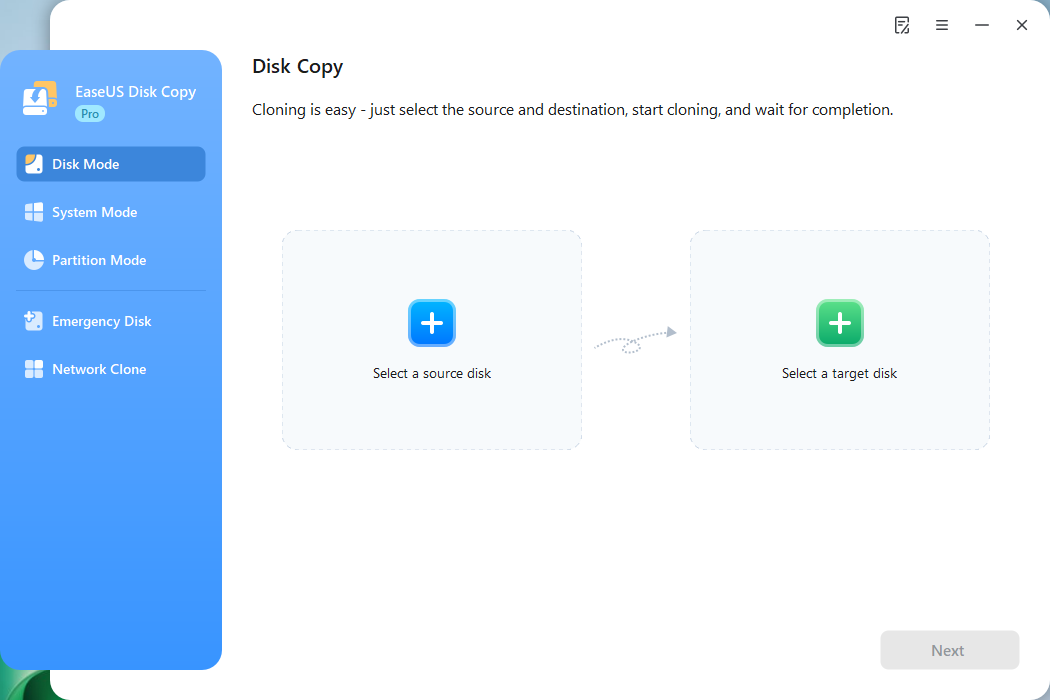If you've been using SD cards for a while, you know that they are not infallible. An SD card can become corrupted due to physical damage, software errors, human error, or other factors. When this happens, you may lose access to all of the data stored on the card.
Fortunately, there are ways to backup and restore SD cards so that you can recover your data if something goes wrong. In this article, we'll show you how to backup and restore an SD card on Android, PC, and Raspberry Pi.
Ⅰ. What Is SD Card? Three Types of SD Cards You Should Know
SD cards are small, portable storage devices that are often used in digital cameras, camcorders, and smartphones. SD cards are a category of memory card for storing data. There are currently three sub-types of secure digital cards: SD, SDHC, and SDXC, but they are all commonly known as SD cards.
Memory cards of the three types come in a variety of sizes and speeds, which can be confusing for some people. Here's a quick rundown of the different types of memory cards:
- Secure Digital (SD) cards: These are the most common type of SD cards. They come in three different sizes: Standard SD (32mm x 24mm), Mini SD (21.5mm x 20mm), and Micro SD (15mm x 11mm). Standard SD cards are typically used in digital cameras, while Mini SD and Micro SD cards are used in smartphones and other portable devices. (microSD card is previously known as TF card. Know better at TF card vs. SD card→)
- Secure Digital High Capacity (SDHC) cards: These cards are similar to standard SD cards, but they have a higher capacity (4GB to 32GB). They are typically used in digital cameras and camcorders.
- Secure Digital Extended Capacity (SDXC) cards: These cards have the highest capacity of any SD card (64GB to 2TB). They are typically used in high-end digital cameras and camcorders.
Take a glance at the main types of memory cards: SD card, SDHC card, and SDXC card
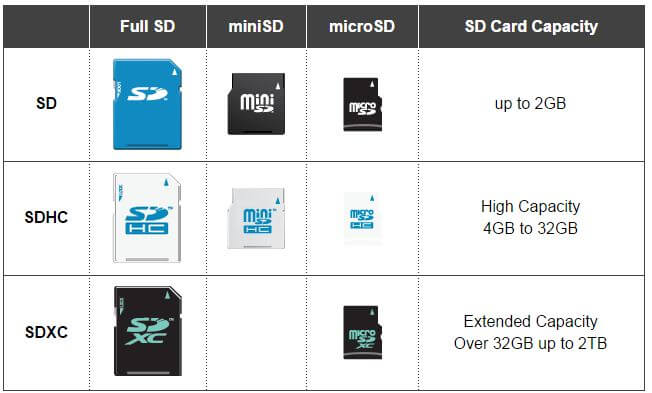
Besides the three types, you may have heard of SDUC cards, which are designed to cover cards ranging from 2TB up to 128TB. It's a newer specification that's not widely used at the moment.
Ⅱ. SD Card Application and Trends in 2022
Now that we've gone over the different types of SD cards, you might be wondering what devices are still using them. While many newer devices are starting to use other types of storage (such as microSDXC), there are still a few devices that rely on SD cards.
- Digital cameras: Many digital cameras continue to use SD cards for storing photos and videos. Some newer models are starting to use other types of storage, such as microSDXC, but SD cards are still a popular option.
- Camcorders: Like digital cameras, camcorders often use SD cards for storing video footage for filmmaking or vlogs. Again, some newer models are starting to move away from SD cards, but they remain a popular option.
- Smartphones: A few smartphones still use SD cards for expandable storage, especially those high-end Android smartphones which start supporting 8k video recording in 2020. Nearly 70% of all digital media consumption goes to a mobile device. However, most newer smartphones (such as the iPhone) do not have this feature.
- Consoles: Gaming consoles, such as the Nintendo Switch, and Steam Deck, use SD cards for storing large game downloads, patches and updates, to ensure the gaming performance won't be affected by insufficient memory.
- VR headsets: Virtual reality headsets, such as the Oculus Rift and HTC Vive, use SD cards for storing VR content. It is said that a typical interactive VR application can generate about 1TB of data per hour.
- Dashboard cameras or dash cams: Being a part of safety technologies, dash cams use SD cards to store video footage of car journeys as vehicles don't have built-in memory to store the recorded footage.
- Drones: Drones are playing a role in data collection while flying high up in the air, it requires robust storage solutions to ensure performance. And, that's to be advanced SD cards of big brands like Samsung, SanDisk, Delkin, or Lexar.
We don't name all the devices that require SD cards, SDHC cards and SDXC cards for expandable storage, but you get the idea. While SD cards are slowly being replaced by other storage solutions like eMMC, they're still widely used in many devices. With the worldwide COVID-19 pandemic still going on, people are developing hobbies in photographing, vlogging, playing games, and VR traveling which all heavily depend on memory card storage. So the demand for SD cards will keep rising in 2022.

[Image credit: global secure digital memory card market to 2028 at https://www.researchandmarkets.com]
Ⅲ. Now, You Got 100 Reasons to Back Up SD Card
SD card is universally applied in digital products and the market share is still growing, so it's of great significance to command the basic skills of making backups and maintaining a healthy state of your SD card.
On the one hand, SD card backup is a precautionary measure that deserves your attention. On the other hand, a backup of the SD card is essential when something goes wrong with your SD card and needs to be repaired. Most of the time, we use "formatting" to repair a corrupted or damaged SD card, and disk formatting is the reconfiguring process of the SD card for initial use, which will erase all data on it.
Not limited to repairing SD cards, disk formatting is an effective solution to solve the incompatibility issue of SD cards that Android can not recognize, PC, or other operating systems and devices due to the improper FAT32, exFAT, or NTFS problems.
LEARN MORE
Disk formatting can help repair common SD card corruption problems, but it will erase data on the SD card, making it essential to know how to back up the SD card before formatting.
Ⅳ. How Do You Back up SD Card?
Since the SD card is set to be removable from any digital device, so when doing backups, we usually copy the data from the SD card to another place, which can be another SD card, a larger USB flash drive, an external hard drive, a computer or a cloud app/drive! Any spare storage location that is available to you can be a backup destination.
Then speaking of SD card backup, there are multiple ways to make it happen. For example:
- Manual copy and paste
- Upload to cloud
- Transfer SD card data to computer
- Create a backup image
- Clone SD card
Among all these implementations, some require the help of a computer, while some can be done on your Android smartphone. Let's go through the complete guide on how to back up SD card photos and videos with or without a computer.
Ⅴ. How to Backup SD Card on a Computer
By taking out the SD card and connecting it to a computer, you can select any of the following methods to make a worry-free SD backup to your preferred location.
What you need:
1. Insert SD card into your PC: Plug it into the proper card slot, which is located either directly on the PC's console or via a memory card adapter attached to a USB port.
2. Check the SD card connection: Usually, Windows will instantly recognize the SD card and mount it into the computer system, so you can browse the SD card content to view and edit by opening the Windows File Explorer.
- Advantages: Zero cost; 100% copy source files without date, size, and properties change
- Disadvantages: Cannot work for programs and system files; time-consuming for large files copy; cannot paste copied files to a network drive or cloud
- Backup Security level: Low
To summarize, the manual method of copying and pasting SD card files on a computer is suitable for 2GB~8GB SD card backup. SD card that contains massive data over 16GB, this kind of backup method is too elementary to be good.
Step 1. Double-click the SD card in File Explorer. Here are some hotkeys for you to select some or entire files in the first place.
- Hold Ctrl and selectively click on the files you want to back up.
- Press Ctrl + A to select all files on the SD card
Step 2. If you're going to save the copy to a local drive on your PC, or another removable storage drive, here's a tip for you. Create a new folder named "backup" or something you're familiar with on that drive, and press Ctrl + C and then Ctrl + V to paste it there.

- Advantages: Backup accessible on multiple devices after login
- Disadvantages: 5GB storage is free
- Backup Security level: Medium to High
Since you're using a Windows computer, a OneDrive folder is created on your PC above the This PC folder. OneDrive is the Microsoft cloud service that connects you to all your files. It lets you store and protect your files, share them with friends, and, most importantly, access backup files from anywhere on all your devices. So, cloud storage is an excellent place to go when it comes to backing up photos and videos, which are usually large files.
Step 1. For the first time using OneDrive, you'll need to register, log in to it and complete the setup with the on-screen guide.
Step 2. Next, the backup process is all about another copy and paste. Select SD files, and copy and paste them (drag and drop also works) to the OneDrive folder. That'll be done.

- Advantages: free; save disk space; backup on a schedule
- Disadvantages: require downloading backup software
- Backup Security level: Very high
Only by downloading a Windows backup and recovery software can you make option 3 effective. Here, a backup image refers to making a copy of SD card content and saving the backup as a single file with a specific file format, as you may hear of ISO, VHD, etc. Being different from the traditional copy and paste way, as well as cloud synchronization, the backup image needs to use special software to create and restore.
EaseUS free backup software is universally acknowledged as the most user-friendly yet powerful in doing all kinds of backups. It can connect to your cloud account of Google Drive, OneDrive, and Dropbox as well, so you can still keep the SD backup to the cloud. However, those third-party cloud services offer limited free storage, while in EaseUS Todo Backup, every user can enjoy 250GB of free cloud storage. That's another reason why it has become the best Windows backup software for SD cards.
Secure Download
Step 1. Start with selecting the backup contents.

Step 2. There are four backup categories, File, Disk, OS, and Mail, click Disk.

Step 3. It is available to back up a whole disk or a certain partition. Choose the one you need and click OK.
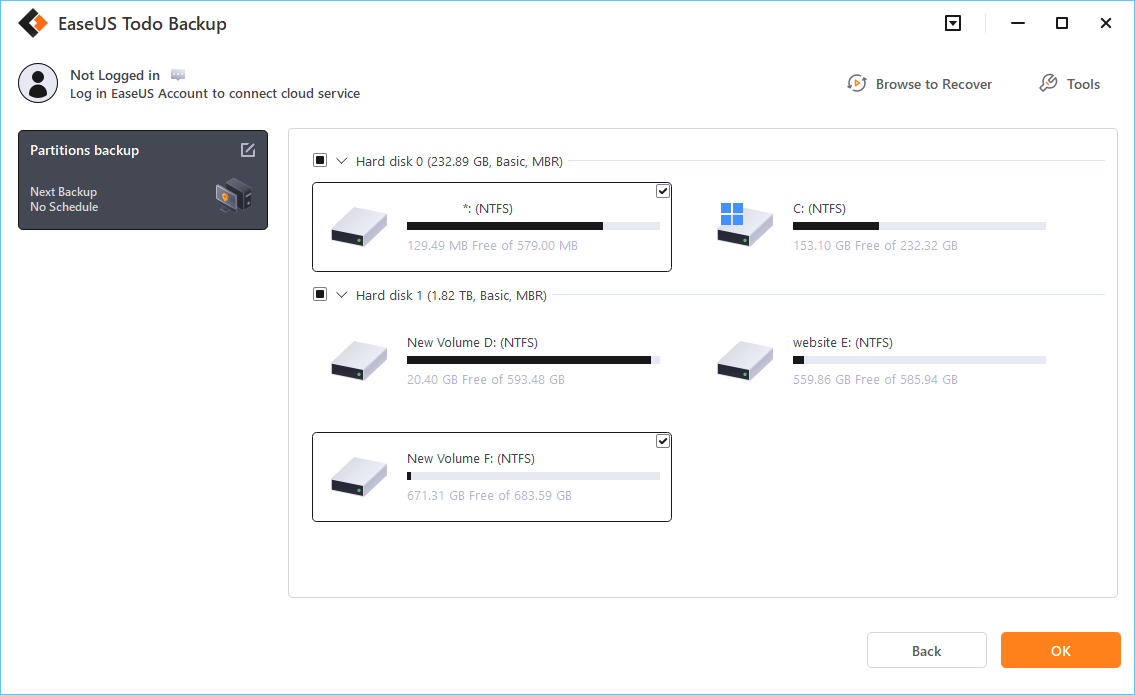
Step 4. Select the destination where you want to save the backup.
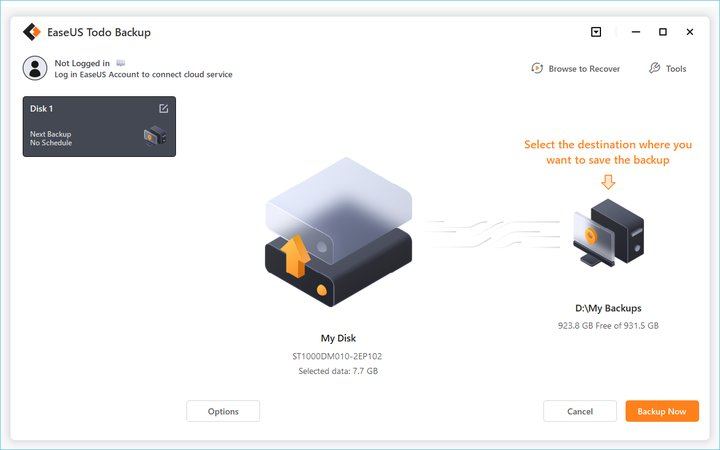
Step 5. For disk/partition backup, you can choose to save the backup to local drive or to NAS.
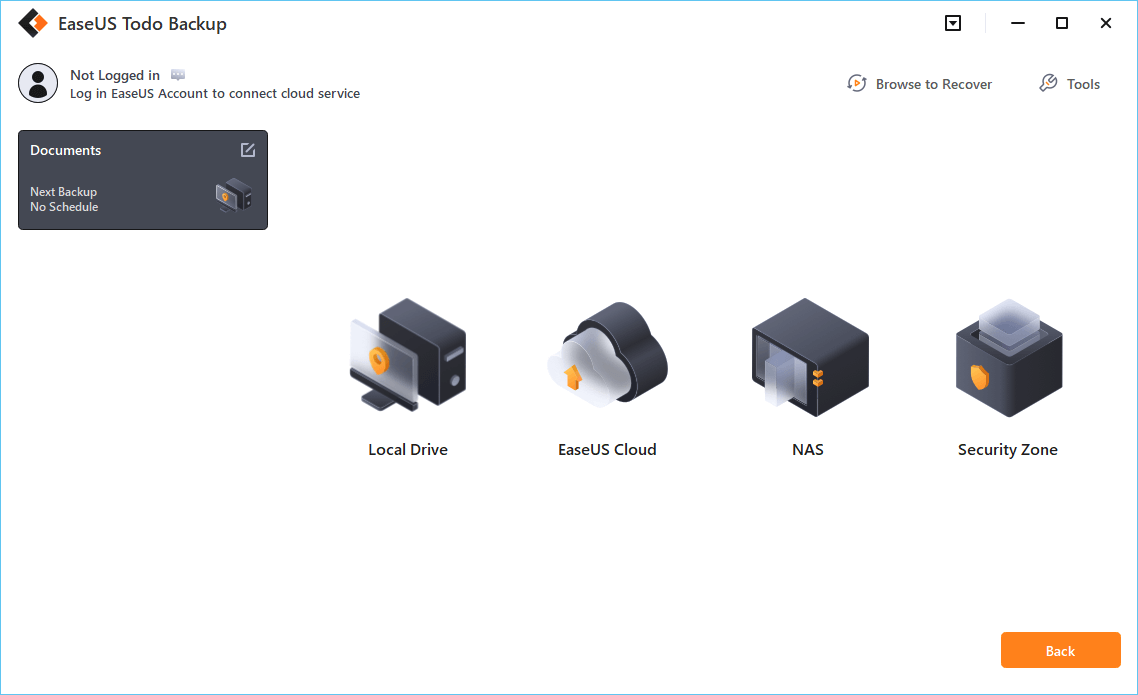
Step 6. After the backup process is completed, your task will be displayed at the left. Right-click any one of the task, you can further manage your backup such as recover it, create incremental backup, etc.

LEARN MORE
Here's a roundup review of the top 5 best SD card backup software available on the market. EaseUS Todo Backup is the best for users looking for a handy, multifunctional, and reliable solution to SD card backup and restore.
Secure Download
- Advantages: make an identical copy of the original SD card; being able to back up a corrupted SD card
- Disadvantages: Paid software starts at $19.90 per month
- Backup Security level: Very high
Cloning is widely accepted as the most effective way to replace a hard drive without moving data or reinstalling the operating system. However, in some cases, disk cloning can be used to make a backup, primarily to back up a hard drive that has problems with data recovery. Hence, if you're trying to change a new SD card for a camera or smartphone and want to make a backup of the old SD card, why not choose to directly clone the old card to a new card for an instant backup and recovery purpose? Here, EaseUS Disk Copy is so far the most highly recommended cloning software for a variety of storage drives.
Step 1. Prepare New Drive
- Backup data: If the target drive contains data, back it up before cloning because cloning will wipe all data on the target disk.
- Connect the disk to your PC: For desktops or laptops with more than one slot, install it internally. For laptops with only one slot, use an external disk enclosure or a SATA-to-USB adapter to connect the disk externally to the PC.
Step 2. Run Disk Cloning Software
- Download, install, and open EaseUS Disk Copy.
- Choose Disk Mode.
Step 3. Select Source and Target Drives
- Select the old disk as the source.
- Select the new disk as the destination.
- Check whether enabling the "Preview partition layout" box for the advanced feature.
Note: Adjust disk layout if necessary.
- Select "Autofit the disk" to make full use of the larger capacity on the destination disk.
- Select "Copy as the source" to use "Sector-by-sector copy" feature.
- Select "Edit disk layout" to manually resize the disk layout on destination drive.
Step 4. Start Cloning
- Confirm the warning message (data on the destination drive will be erased) and start cloning.
- Wait for the cloning process to be complete.
Ⅵ. How to Back up SD Card on Android Without Computer
With the development of technology and information in modern society, mobile phones and tablets have become the mainstream devices for playing games, watching videos, and taking photos. The more you use a mobile phone, the less you spend time on a PC or laptop. The same is valid for backing up an Android SD card. Is there a backup method that can be done directly on the Android phone without bothering to find a computer for help? The answer is positive. Here, we will introduce three attainable solutions for you.
- Advantages: make an identical copy of the original SD card; being able to back up a corrupted SD card
- Disadvantages: Paid software starts at $19.90 per month
- Backup Security level: Very high
This is the most direct and accessible way to back up SD card photos and videos on Android without using a computer, but this requires you to download or purchase a cloud app on Google Play. Some of the reputable apps are Dropbox, pCloud, Box, IDrive, and Microsoft OneDrive. Some branded phones also offer a native cloud service, for example, Samsung cloud, and you can check if your phone has one or not in Settings.
Since Google photos are popular, we'll show an example of how to backup an SD card to Google Photos here:
Step 1. Open the Google Photos app on your Android device.
Step 2. At the top left, touch the "menu" icon with three horizontal lines.
Step 3. Select "Settings > Back up & sync". If it's not enabled, turn it on.

Step 4. Tap "Choose folders to back up..." and select the SD card photo folder like DICM you want to back up. Wait for the backup process to complete.
LEARN MORE
Google offers two different apps you can use to upload and back up SD card photos. Besides Google Photos, you can learn how to backup SD card to Google Drive for more free storage space.
- Advantages: No need for a computer or laptop, backup SD card on Android directly; backup multiple SD cards at the same time; support to wirelessly stream media content from an external drive to an Android phone.
- Disadvantages: A little bit expensive compared with other methods ($39.99)
- Backup Security Level: Medium to High
The FileHub from Ravpower is an external storage device that can be used to connect multiple devices at the same time and perform file transfers between them. It is designed for data backup, content sharing, and streaming between SD cards, USB drives, HDDs, and mobile phones.

How to use FileHub for backing up an SD card without a computer:
Step 1. Connect your SD card to the FileHub via the USB port.
Step 2. Connect your Android phone to FileHub via Wi-Fi.
Step 3. Find the files you want to back up in the FileHub app and copy them to your phone.
LEARN MORE
The purpose of SD card backup devices is to create a backup copy of memory cards. So you can create a full copy of the contents of a memory card on a computer or in other places. Check the top five SD card backup devices that are worth buying.
Ⅶ. How to Back up a Raspberry Pi SD Card in Windows
Raspberry Pi is a tiny, affordable computer that you can use to learn to program, build electronics projects and create powerful IoT devices. The Raspberry Pi will not work without an SD card.
A Raspberry Pi SD card is a tiny memory card that is used to store the operating system and software for the Raspberry Pi. We know that the SD card for Raspberry Pi is small and easy to lose. After customizing your Raspberry Pi OS and installing some useful software, you may want to regularly back up the SD card before upgrading the system or making other changes. Hence, backing up the Raspberry Pi SD card is backing up the Raspberry Pi operating system. In this way, if something goes wrong with your Raspberry Pi, you can quickly restore it from the backup image.
Next, we'll show you the simplest method to backup the Raspberry Pi SD card on Windows 11/10/8.1/7:
Step 1. To be able to back up the Raspberry Pi SD card on Windows, we must use a Raspberry Pi backup software called Win32 Disk Imager. So, download and install the program to prepare for the next move.
Step 2. Now you remove the SD card from your Raspberry Pi computer, insert it into the card reader, and then plug it into your PC. Open Win32 Disk Imager to run.

Step 3. Choose the device at the top right corner and click on the Folder icon to navigate to a drive and directly enter a .img file name in the File name box, for example, Raspberrypi_backup.img and then click Open. Or, you can directly enter x:/Raspberrypi_backup.img in the Image File section. X is for the drive letter of your backup destination. Click Read to start creating the image file.

Step 4. Once completed, the Raspberry Pi SD card will be written to an image file named Raspberrypi_backup.img in the backup location.

LEARN MORE
Still curious? Find more solutions to backup SD card for Raspberry Pi on Windows, Linux, and Mac.
Ⅷ. Conclusion of SD Card Backup
To wrap things up, the shared solution of SD card backup with or without a computer is to upload SD card files to the cloud. All you need is to choose a reliable cloud service, which can be a free or paid one. Compared with the most free cloud storage to keep backups from your SD card or other storage devices, EaseUS cloud backup software offers 250GB of free cloud storage, which is the best value of free choice.
Secure Download
Another way to back up SD card for smartphones or Raspberry Pi computers is to clone an SD card, which is mainly for the A-to-A copy of SD card files and structures, and additionally for backup and restoring a corrupted SD card data.
Last but the least, when you have multiple SD cards to be backed up, which can be of a digital camera or a game console, you can use a physical SD card backup device. The most recommended is the FileHub from RavPower.
Was This Page Helpful?
Updated by Jerry
"I hope my articles can help solve your technical problems. If you are interested in other articles, you can check the articles at the bottom of this page, and you can also check my Facebook to get additional help."
Jean is recognized as one of the most professional writers in EaseUS. She has kept improving her writing skills over the past 10 years and helped millions of her readers solve their tech problems on PC, Mac, and iOS devices.
Related Articles
-
[July 2026] Complete Guide on How to Backup Computer (Windows & Mac)
![author icon]() Jean/Jan 05, 2026
Jean/Jan 05, 2026 -
File Backup - 2026 Guide to Understand It Comprehensively
![author icon]() Larissa/Jan 05, 2026
Larissa/Jan 05, 2026 -
(2026) An Ultimate Guide to Backup Hard Drive and Restore Your Computer
![author icon]() Jean/Jan 05, 2026
Jean/Jan 05, 2026 -
A Complete Guide to System Image Recovery in Windows 11/10/8.1/7
![author icon]() Jean/Jan 05, 2026
Jean/Jan 05, 2026
